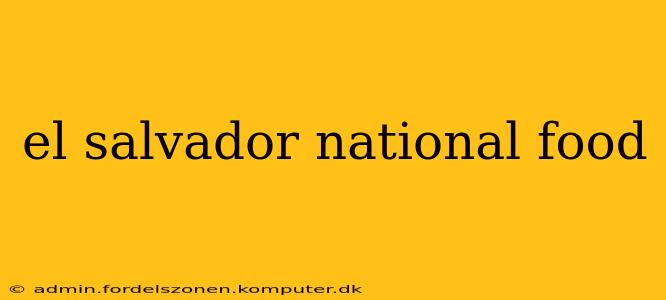El Salvador, a vibrant Central American nation, boasts a rich culinary heritage far exceeding its most famous dish. While pupusas rightfully hold a prominent place in Salvadoran cuisine, exploring the country's national food involves uncovering a tapestry of flavors and traditions reflecting its indigenous roots and colonial influences. This deep dive will not only cover pupusas but also explore other essential dishes and answer some frequently asked questions about Salvadoran food.
What is the most popular food in El Salvador?
Undoubtedly, pupusas reign supreme as El Salvador's most popular food. These thick, handmade tortillas are filled with a variety of savory ingredients, most commonly queso (cheese), chicharrón (pork rinds), frijoles (beans), or a combination thereof. Served with a side of curtido (a tangy cabbage slaw) and salsa roja (a spicy tomato sauce), pupusas are a staple at every celebration and a daily comfort food for many Salvadorans. Their popularity extends beyond the borders of El Salvador, with pupuserias (pupusa restaurants) popping up in many parts of the world. However, it's important to remember that pupusas are only one aspect of El Salvador's diverse culinary landscape.
What are some other traditional Salvadoran dishes?
Beyond pupusas, El Salvador offers a delightful array of traditional dishes. Here are a few examples:
- Yuca frita: Fried yuca (cassava) is a common side dish, often served with a dipping sauce. Its crispy exterior and soft interior complement many main courses.
- Pastelitos de carne: Savory pastries filled with seasoned ground beef, these are a delicious and portable snack or light meal.
- Arroz con pollo: A simple yet satisfying dish of rice cooked with chicken, often seasoned with achiote for a vibrant color and distinctive flavor.
- Sopa de gallina india: This hearty chicken soup, flavored with traditional spices, is a comforting and nourishing meal, often enjoyed on cooler days.
- Empanadas: Similar to pastelitos but often featuring different fillings and a slightly different pastry crust. These savory hand pies are a popular street food.
What are the main ingredients in Salvadoran cuisine?
Salvadoran cuisine is characterized by its use of readily available, fresh ingredients. Key ingredients include:
- Maize (corn): The foundation of many dishes, from pupusas to tortillas.
- Beans: A staple source of protein, frequently incorporated into stews, pupusas, and other dishes.
- Chicken and pork: Popular protein sources, often used in stews, soups, and as fillings for pastries.
- Yucca: A versatile root vegetable used in various dishes, both sweet and savory.
- Plantains: These starchy fruits are often fried or cooked into sweet or savory dishes.
- Achiote: A spice that imparts a vibrant red color and earthy flavor to many Salvadoran dishes.
Is there a national dish of El Salvador?
While pupusas are undeniably the most iconic and widely recognized Salvadoran dish, there isn't an officially declared "national dish." Pupusas' popularity and cultural significance make them effectively the national food, but the diverse array of other delicious and traditional dishes reflects the country's rich culinary heritage.
What drinks are popular in El Salvador?
Beyond the food itself, El Salvador's beverage culture is equally rich. Popular drinks include:
- Horchata: A refreshing rice milk beverage often flavored with cinnamon and sugar.
- Atole: A thick, warm corn-based drink, often sweetened and spiced.
- Various fruit juices: Freshly squeezed juices from local fruits like mango, pineapple, and tamarind are common.
- Coffee: El Salvador is known for its high-quality coffee, and a cup of "café" is a daily ritual for many.
Exploring the national food of El Salvador is an adventure that goes beyond simply trying pupusas. By delving into the variety of ingredients, traditional recipes, and beloved dishes, one can truly appreciate the rich culinary tapestry that defines this Central American nation. The warmth and vibrancy of Salvadoran food reflect the heart and soul of its people.
